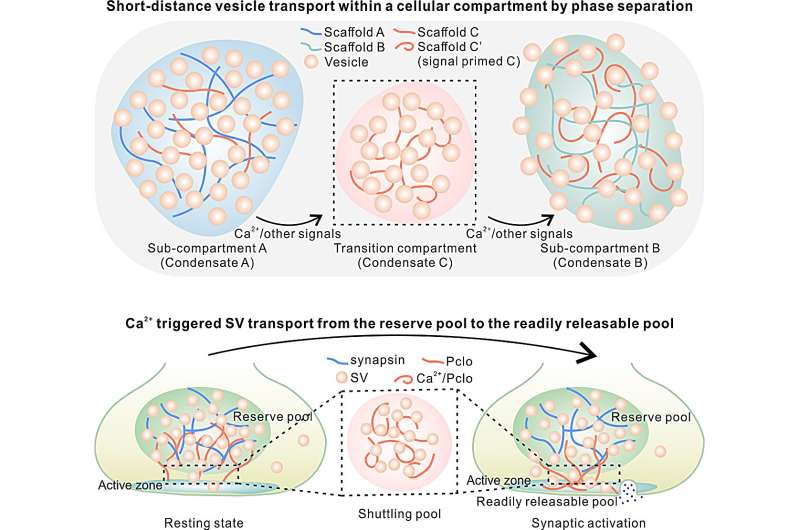This article has been reviewed according to Science X's editorial process and policies. Editors have highlighted the following attributes while ensuring the content's credibility:
fact-checked
peer-reviewed publication
trusted source
proofread
Researchers uncover mechanism for short-distance vesicle movements

Researchers at the Hong Kong University of Science and Technology (HKUST) have thrown new light on the mechanism for how vesicles move short distances within specific parts of the cell, an area not understood by scientists.
Vesicles are small cellular containers that perform a variety of functions, including helping to move materials, such as proteins, lipids, and other cellular components, that an organism needs to survive and recycle waste materials.
Besides using molecular motors for long-distance transport, cells also need to move vesicles short distances within specific parts of the cell. But the exact mechanisms for this short-distance transport remain a topic of research among scientists.
To address this challenge, a research team from the Division of Life Science at HKUST, led by doctoral student Mr. Qiu Hua and RGC Postdoctoral Fellow Dr. Wu Xiandeng, with the guidance of Prof. Zhang Mingjie, former Chair Professor in Life Science at HKUST, and Prof. Wu Zhenguo, Professor in Life Science of HKUST, focused their investigation on the movement of synaptic vesicles (SVs). They discovered that the separation of specific proteins associated with these vesicles enables them to move in a controlled manner between different regions of the cell.
Specifically, a large protein called Piccolo, which forms coils, can grab SVs from one area called the reserve pool and place them in another area called the active zone in response to calcium signals.
They also found that another protein called TFG helps in moving vesicles from the endoplasmic reticulum (ER) to another cellular structure called the ER-Golgi intermediate compartment by using a similar process of phase separation.
Their findings suggest that phase separation might be a common way cells regulate the short-distance movement of vesicles in specific directions.
The study, titled "Short-distance vesicle transport via phase separation", was recently published in the journal Cell.
In cells, vesicles need to move in specific directions to meet various needs. For longer distances between different parts of the cell, they rely on molecular motors attached to the cell's structural framework, called the cytoskeleton.
However, within smaller areas of the cell, vesicles also need to move short distances. For instance, in the Golgi apparatus, which processes and sorts proteins, vesicles move rapidly over distances of just a few hundred nanometers. Similarly, at nerve cell terminals, synaptic vesicles shuttle quickly from storage sites to release sites over distances of several hundred nanometers, precisely timed for neurotransmitter release.
In contrast to long-distance vesicle transport, very little is known regarding how local directional vesicle movements are achieved in cells, except that they are known not to involve molecular motors.
Crucially, this study identifies some of the active processes in cells that help vesicles move locally over short distances in specific directions.
"Our study demonstrates that short-distance and directional transport of vesicles can occur through phase separation of vesicles with protein condensates, without the involvement of molecular motors, which may be adopted in various other situations within the broader field of cell biology. Therefore, an important future direction is to expand our discovery of this new vesicle transport mechanism in the synapse to other cellular processes that are more commonly studied," Dr. Wu said.
More information: Hua Qiu et al, Short-distance vesicle transport via phase separation, Cell (2024). DOI: 10.1016/j.cell.2024.03.003
Journal information: Cell
Provided by Hong Kong University of Science and Technology





















